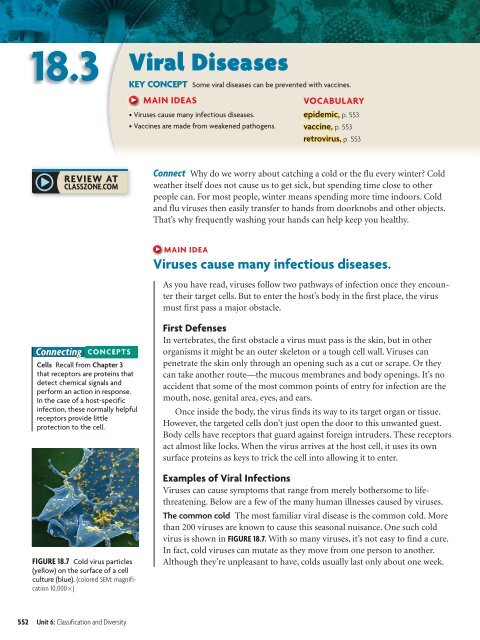18.1 Studying Viruses and Prokaryotes
18.1 Studying Viruses and Prokaryotes
18.1 Studying Viruses and Prokaryotes
Create successful ePaper yourself
Turn your PDF publications into a flip-book with our unique Google optimized e-Paper software.
18.3Viral DiseasesKEY CONCEPT Some viral diseases can be prevented with vaccines.MAIN IDEAS• <strong>Viruses</strong> cause many infectious diseases.• Vaccines are made from weakened pathogens.VOCABULARYepidemic, p. 553vaccine, p. 553retrovirus, p. 553Connect Why do we worry about catching a cold or the flu every winter? Coldweather itself does not cause us to get sick, but spending time close to otherpeople can. For most people, winter means spending more time indoors. Cold<strong>and</strong> flu viruses then easily transfer to h<strong>and</strong>s from doorknobs <strong>and</strong> other objects.That’s why frequently washing your h<strong>and</strong>s can help keep you healthy.MAIN IDEA<strong>Viruses</strong> cause many infectious diseases.As you have read, viruses follow two pathways of infection once they encountertheir target cells. But to enter the host’s body in the first place, the virusmust first pass a major obstacle.Connecting CONCEPTSCells Recall from Chapter 3that receptors are proteins thatdetect chemical signals <strong>and</strong>perform an action in response.In the case of a host-specificinfection, these normally helpfulreceptors provide littleprotection to the cell.FIGURE 18.7 Cold virus particles(yellow) on the surface of a cellculture (blue). (colored SEM; magnification10,000)First DefensesIn vertebrates, the first obstacle a virus must pass is the skin, but in otherorganisms it might be an outer skeleton or a tough cell wall. <strong>Viruses</strong> canpenetrate the skin only through an opening such as a cut or scrape. Or theycan take another route —the mucous membranes <strong>and</strong> body openings. It’s noaccident that some of the most common points of entry for infection are themouth, nose, genital area, eyes, <strong>and</strong> ears.Once inside the body, the virus finds its way to its target organ or tissue.However, the targeted cells don’t just open the door to this unwanted guest.Body cells have receptors that guard against foreign intruders. These receptorsact almost like locks. When the virus arrives at the host cell, it uses its ownsurface proteins as keys to trick the cell into allowing it to enter.Examples of Viral Infections<strong>Viruses</strong> can cause symptoms that range from merely bothersome to lifethreatening.Below are a few of the many human illnesses caused by viruses.The common cold The most familiar viral disease is the common cold. Morethan 200 viruses are known to cause this seasonal nuisance. One such coldvirus is shown in FIGURE 18.7. With so many viruses, it’s not easy to find a cure.In fact, cold viruses can mutate as they move from one person to another.Although they’re unpleasant to have, colds usually last only about one week.552 Unit 6: Classification <strong>and</strong> Diversity
















